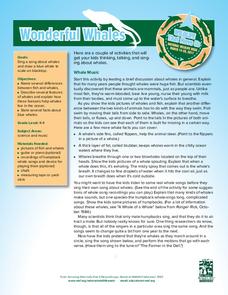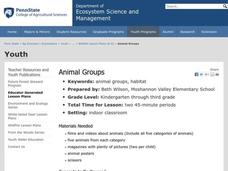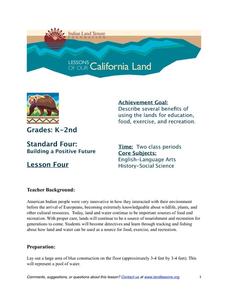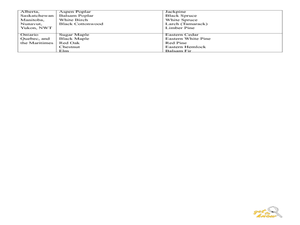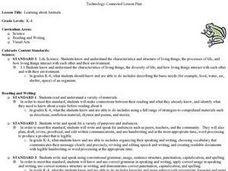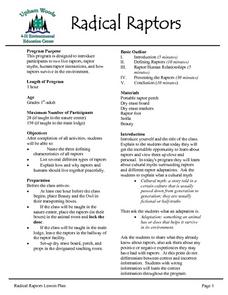Purdue University
Common Indiana Mammals
Mammals all have their own story to tell. A set of 34 cards outlines the key characteristics of different mammals. The cards include images of each mammal as well as their skulls and tracks. The back of the cards describe characteristics...
National Wildlife Federation
Tricky Tracks
While wildlife may not always be visible, they leave their marks behind for people to discover. A wildlife lesson has pupils explore the characteristics of animal tracks. They learn different types of tracks, as well as what tracks tell...
Curated OER
What are Mammals?
Pupils differentiate between wild and tame animals, explain how to classify mammals into groups based on common charactertistics and comprehend the values of zoos. They listen as the teacher reads Psalm 50:10 and explains that all of the...
Purdue University
Mammal Food Webs
You are what you eat—or at least a part of what you eat. Budding scientists examine owl pellets to develop their own food webs. They use tooth and skull identification techniques to classify what they find.
Curated OER
Home Away From Home
Students discover some of the threats to tigers in the wild and some of the challenges of keeping them in wildlife preserves and zoos. They then sketch and explain their designs for sensible tiger enclosures in zoos.
Curated OER
Mammals of Wisconsin
Young scholars explore the exciting world of mammals as they learn the identities of some Wisconsin native residents. They examine their adaptations and learn how they survive in a state with a wide array of temperatures and ecosystems.
Curated OER
Wonderful Whales
Primary marine biologists consider the largest living animals on Earth, the whales. Introduce them to general anatomy, unique adaptations, and behaviors. Teach them to sing a song that will help them remember some of these facts....
Curated OER
Classification of Animals
First graders investigate the characteristics of vertebrates. They classify each as mammal, fish, bird, and reptiles. Students explore the differences between various types of animals and classify each.
Curated OER
Animals
Students become familiar with the need for categorizing scientific information, in this case, animals. They categorize the 5 groups of animals in a collage and answer questions about each.
Purdue University
The Great Clearcut Controversy
Urban development and habitat retention are often at odds. A three-part lesson examines the pros and cons of forest clearcutting. Learners review data and characteristics of a specific mammal to make conclusions about the effect...
Curated OER
Animal Classification
Students recognize the six groups of animals (Mammals, fish, birds, reptiles, amphibians and arthropods) and their characteristics. For this animal characteristics lesson, students sort animals by their traits. Students cut and paste...
Curated OER
Animal Groups
Young scholars explore animal groups. In this animal science lesson, students use pictures from magazines and classify the animals into five categories. Young scholars share why they categorized the animals the way they did.
Indian Land Tenure Foundation
Gifts from Land and Water
With a series of fun hands-on simulations, young children can learn about conservation and natural resources. Your learners become land detectives, discussing and investigating the gifts that the land and water provide them. They then...
Curated OER
Endangered species
Students define the following words: extinction, endangered species, meteorite collision, glaciation and climate warming. They investigate that there are 307 species on the endangered list, and an average of 10-20 species are added each...
Curated OER
What Is Happening To My Species?
Students select and research an animal that lives in the rainforest of Manu, Peru. They watch and discuss a video, create masks and costumes to role-play various rainforest animals, conduct research, and write a short story of their...
Curated OER
Get to Know Trees
Students recognize the characteristics of trees by using their five senses. In this trees lesson, students observe and record the characteristics of trees on a field trip. Students then are blindfolded and use their senses to identify...
Curated OER
Home Sweet Home
Students examine the animals that live in trees. They identify their sounds, footprints and droppings. They draw pictures of the animals as well.
Curated OER
Learning about Animals
Students chose one animal to research. They research the animal using the internet using the sites provided. They also research using books from the library. They conclude the lesson by writing a one page story about their animal...
Curated OER
Radical Raptors
Students are introduced to raptors and their role in the environment. They identify three characteristics of raptors and list several types of raptors found in nature. They discuss their positive and negative experiences with raptors and...
Curated OER
Birds of Wisconsin
First graders explore the job done by ornithologists. They role play identifying the characteristics that make a bird a bird. They discuss what makes each bird species unique. Students are introduced to Wisconsin's most common and rare...
Curated OER
Dolphin Documentary
Young scholars use their knowledge of dolphin natural history to create a "movie."








